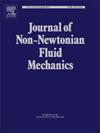Stagnation point flow of a viscoplastic fluid
IF 2.8
2区 工程技术
Q2 MECHANICS
引用次数: 0
Abstract
Stagnation points occur in many configurations, such as flow around blunt objects, flow through a T-junction, and squeeze flow between plates. For viscoplastic fluids, vanishing strain rate at a stagnation point results in regions of stagnant unyielded fluid, or “plugs”. We explore the planar flow of a Bingham fluid in the neighbourhood of a stagnation point in a general flow configuration. When the Bingham number is small, this local problem reduces to the prototypical problem of stagnating flow against an infinite planar boundary, varying only with the stagnation angle with which the flow approaches the boundary. We compute numerical solutions of this idealised problem, using the augmented-Lagrangian algorithm, and determine the geometry of the stagnation-point plug as a function of this stagnation angle. As the angle decreases, the plug becomes larger, is elongated in the flow direction, and becomes increasingly asymmetric. However, for all angles, the plug features a right-angle at its vertex, a result that we demonstrate numerically and prove direct from the model equations. We also show how local stagnation plugs are embedded in global flows, illustrating the results from the specific case studies of recirculating flow in a sharp corner and uniform flow around an elliptic cylinder.

粘塑性流体的滞止点流动
在许多结构中都会出现滞止点,例如围绕钝物体的流动,通过t型结的流动,以及板间的挤压流动。对于粘塑性流体,在驻点处应变速率消失会导致停滞未屈服流体的区域,或“堵塞”。我们研究了一般流动形态中宾厄姆流体在驻点附近的平面流动。当Bingham数较小时,该局部问题简化为沿无限平面边界的停滞流动的原型问题,仅随流动接近边界时的停滞角而变化。我们计算了这个理想问题的数值解,使用增广拉格朗日算法,并确定了作为该停滞角函数的停滞点塞的几何形状。随着角度的减小,桥塞变得更大,在流动方向上被拉长,并且变得越来越不对称。然而,对于所有角度,塞子在其顶点处都有一个直角,我们用数值方法证明了这一结果,并直接从模型方程中证明了这一点。我们还展示了局部滞流塞如何嵌入到全局流动中,并举例说明了尖角再循环流动和椭圆圆柱体周围均匀流动的具体案例研究结果。
本文章由计算机程序翻译,如有差异,请以英文原文为准。
求助全文
约1分钟内获得全文
求助全文
来源期刊
CiteScore
5.00
自引率
19.40%
发文量
109
审稿时长
61 days
期刊介绍:
The Journal of Non-Newtonian Fluid Mechanics publishes research on flowing soft matter systems. Submissions in all areas of flowing complex fluids are welcomed, including polymer melts and solutions, suspensions, colloids, surfactant solutions, biological fluids, gels, liquid crystals and granular materials. Flow problems relevant to microfluidics, lab-on-a-chip, nanofluidics, biological flows, geophysical flows, industrial processes and other applications are of interest.
Subjects considered suitable for the journal include the following (not necessarily in order of importance):
Theoretical, computational and experimental studies of naturally or technologically relevant flow problems where the non-Newtonian nature of the fluid is important in determining the character of the flow. We seek in particular studies that lend mechanistic insight into flow behavior in complex fluids or highlight flow phenomena unique to complex fluids. Examples include
Instabilities, unsteady and turbulent or chaotic flow characteristics in non-Newtonian fluids,
Multiphase flows involving complex fluids,
Problems involving transport phenomena such as heat and mass transfer and mixing, to the extent that the non-Newtonian flow behavior is central to the transport phenomena,
Novel flow situations that suggest the need for further theoretical study,
Practical situations of flow that are in need of systematic theoretical and experimental research. Such issues and developments commonly arise, for example, in the polymer processing, petroleum, pharmaceutical, biomedical and consumer product industries.

 求助内容:
求助内容: 应助结果提醒方式:
应助结果提醒方式:


